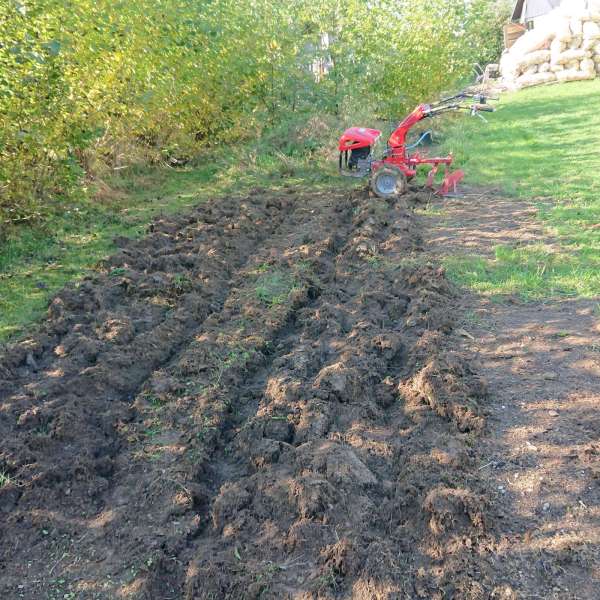Making alliterated titles was a fun (for me) exercise, but I do not think I would be able to keep that up for the next year, even if English were not a foreign language. So this might be the last one.
It is winter, so I cannot do much in the garden. But there are works that need to be done, because I did not manage to do them in the fall due to prolonged lower back trouble. I am fine now, so I am trying to catch up, slowly and carefully.
One of the works was to replant the bamboo that I planted years ago as a sort of wind shield for my greenhouse. It grew extremely poorly where I planted it, and it started to sprawl into areas where I did not want it, and it grew strongly there. I took the opportunity of warm-ish weather, and I dug a 4×1 m hole, lined it with old PVC flooring to contain the spread of the plants. Then I dug out all the bamboo plants, and I planted them inside, covering them with enough sieved soil to, hopefully, shield them from frost. If they survive winter, good. If they do not, I will use this area as a vegetable bed in subsequent years. Between the bamboo and my big greenhouse is a circa 20 m² of tillable soil.
Once the bamboo was planted, I tilled (with a garden fork) the rest of the area where I grew potatoes this year. I could not do it with the plough in the fall, because it was covered with a heap of aforementioned sieved soil. This area is circa 30 m², and I plan to plant it with soy beans.
BTW, it was probably working with the plough that caused me the lower back trouble both in the spring and in the fall. In the future, I will have to spread this work over several days to not overstrain myself. I probably should not do more than an hour or so in one go.
I cannot fill the raised beds now because even when it does not freeze, the soil is all soggy and gluey, and I cannot mix it, neither manually nor in the concrete mixer. I have the type of soil where if you start walking over even a small tilled area, you are several cm taller at the end of it. When I was a kid, I once walked home from school several hundred meters over a tilled field. I never did that again; I had to scrape off the soil from my soles every few dozen steps because the shoes became heavy and unwieldy.
I haven’t done much to my main vegetable patch, except digging out lemon balm. I planted it years ago, but I found out I do not like to use it in any way, anywhere, so I decided to liquidate it. This patch is circa 70 m², and it is the best soil I have. It is still clingy when wet, but it has had stones removed from it for decades, and organic material as well as sand added, so in comparison to what is normally here, it is prime estate. I did not till it, and some of the spinach plants are still surviving. If they survive into spring, I might get some small use out of them after all.
Overall, my tilled/tillable vegetable patches add up to circa 170 m² over the whole garden. That is a respectable area. Just like last year, I want to expand my growing ambitions onto the lawn itself. In one area, where I grew beans this year and where the soil is very poor indeed, I am now trying to kill the grass overwinter by covering it with some old rubber and PVC flooring mats. I do not need to till the soil for beans, and I will probably plant them in rows spaced enough to be able to mow the grass between them with a lawnmower. But if I manage to kill the grass now, the planting should be easier in the spring. I do not count this area into my “arable” land yet, nor the area where I will grow potatoes on the grass, just like this year. I do think, however, that I will be able to expand my growing area by a further 30-50 m², just like I did this year, and hopefully till it in the fall without hurting my back again.
A little timeline – the 70 m2 patch was started by my grandfather. I added circa 50 m² last year and 50 m² this year. I would like to keep this trend up as long as I can. I have to plant this area with vegetables and harvest them, but that is not more work than mowing it uselessly every two weeks.
I am still contemplating what to do with the 25 m², where I grew runner beans this year. Once a year, a honeywagon has to drive over it to empty the septic tank in my water cleaning facility. I could plant it with runner beans last year, because the septic was emptied just before that, but I cannot establish permanent vegetable patches there. I am thinking of tilling it manually and sowing it with alfalfa. Alfalfa could outgrow the grass and establish a permanent growth that survives the occasional truck wheel running over it, and whilst I cannot eat it (and I do not plan on having rabbits), it would still fix nitrogen for superb compost, thus I would get a use out of the area. And alfalfa, unlike grass, does not cause hay fever, so I could let it grow taller between the mowings.






































